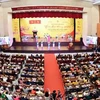 In the festive atmosphere celebrating the 75th anniversary of the August Revolution (August 19, 1945 - 2020) and National Day (September 2, 1945 - 2020), people in Tu Van craft village (Le Loi commune, Thuong Tin district, Hanoi) are busy making national flags as orders come pouring from across the country. Located 30 km south of Hanoi downtown, Tu Van village in the capital’s outlining Thuong Tin district is famed for its embroidery and weaving as it has made millions of national flags for over 70 years. Villagers say they made the national flags used on September 2, 1945, when President Ho Chi Minh read out the Declaration of Independence giving birth to the Democratic Republic of Vietnam at Ba Dinh square. (Photo: VietnamPlus)
In the festive atmosphere celebrating the 75th anniversary of the August Revolution (August 19, 1945 - 2020) and National Day (September 2, 1945 - 2020), people in Tu Van craft village (Le Loi commune, Thuong Tin district, Hanoi) are busy making national flags as orders come pouring from across the country. Located 30 km south of Hanoi downtown, Tu Van village in the capital’s outlining Thuong Tin district is famed for its embroidery and weaving as it has made millions of national flags for over 70 years. Villagers say they made the national flags used on September 2, 1945, when President Ho Chi Minh read out the Declaration of Independence giving birth to the Democratic Republic of Vietnam at Ba Dinh square. (Photo: VietnamPlus)  Today, advanced technologies have been employed to manufacture flags for improved productivity. However, many Tu Van households are still practicing the traditional method of embroidery. Vuong Thi Nhung’s family is a case in point, with three generations embroidering flags. As the traditional method is time and labour consuming, most flags are now made with embroidery machines. But the craft ones possess their own beauty and value and their makers take pride and honour of their work. When national events approach, the national flag (a red flag with a five-pointed yellow star in the centre) is in high demand, and Tu Van villagers enter the peak of their flag production. (Photo: VietnamPlus)
Today, advanced technologies have been employed to manufacture flags for improved productivity. However, many Tu Van households are still practicing the traditional method of embroidery. Vuong Thi Nhung’s family is a case in point, with three generations embroidering flags. As the traditional method is time and labour consuming, most flags are now made with embroidery machines. But the craft ones possess their own beauty and value and their makers take pride and honour of their work. When national events approach, the national flag (a red flag with a five-pointed yellow star in the centre) is in high demand, and Tu Van villagers enter the peak of their flag production. (Photo: VietnamPlus)  The 46-year-old Vuong Thi Nhung has spent more than 30 years embroidering national flags. According to her, the three generations of her family have been embroidering national flags in Tu Van. Her farther had learned flag making techniques for years before passing them on to his offspring. In the recent decade, the demand for national flags has surged, and her family has become busier as a result. The tradition of embroidering flags has been deep-rooted in Tu Van for almost 75 years. From a small traditional village, the rectangular red flags with a golden star in the middle have been distributed far and wide across Vietnam. (Photo: VietnamPlus)
The 46-year-old Vuong Thi Nhung has spent more than 30 years embroidering national flags. According to her, the three generations of her family have been embroidering national flags in Tu Van. Her farther had learned flag making techniques for years before passing them on to his offspring. In the recent decade, the demand for national flags has surged, and her family has become busier as a result. The tradition of embroidering flags has been deep-rooted in Tu Van for almost 75 years. From a small traditional village, the rectangular red flags with a golden star in the middle have been distributed far and wide across Vietnam. (Photo: VietnamPlus)  “Years ago when my father was still alive before passing away at the age of 104, he used to bicycle the flags to our customers on Hang Bong street (Hoan Kiem district, Hanoi). Nearly a century old then, yet he pedaled dozens of miles every single day. He was among the first to bring the flag embroidery craft to Tu Van,” Nhung proudly said. Her farther had learned flag making techniques for years before passing them on to his offspring. In the recent decade, the demand for national flags has surged nationwide, and her family has become busier as a result. (Photo: VietnamPlus)
“Years ago when my father was still alive before passing away at the age of 104, he used to bicycle the flags to our customers on Hang Bong street (Hoan Kiem district, Hanoi). Nearly a century old then, yet he pedaled dozens of miles every single day. He was among the first to bring the flag embroidery craft to Tu Van,” Nhung proudly said. Her farther had learned flag making techniques for years before passing them on to his offspring. In the recent decade, the demand for national flags has surged nationwide, and her family has become busier as a result. (Photo: VietnamPlus)  For a veteran embroiderer like Vuong Thi Nhung, it often takes between 3 and 5 days to complete embroidering a flag. For amateurs, it might take up to a week. Embroidering the national flag is a demanding job that requires a lot of finesses and meticulousness in every stitch, as the final products are for important events. Before coming into being, each flag experiences various steps, with the most important being the selecting of the fine materials. Embroidering the five-pointed golden star in the middle of the flag is the hardest as it is not easy to make the wings symmetrical. (Photo: VietnamPlus)
For a veteran embroiderer like Vuong Thi Nhung, it often takes between 3 and 5 days to complete embroidering a flag. For amateurs, it might take up to a week. Embroidering the national flag is a demanding job that requires a lot of finesses and meticulousness in every stitch, as the final products are for important events. Before coming into being, each flag experiences various steps, with the most important being the selecting of the fine materials. Embroidering the five-pointed golden star in the middle of the flag is the hardest as it is not easy to make the wings symmetrical. (Photo: VietnamPlus)  As a result of a painstaking and time-consuming process, each embroidered flags is sold at a price of at least 300,000 VND (12.94 USD). Embroidering the national flag is a demanding job that requires a lot of finesses and meticulousness in every stitch, as the final products are for important events. For a veteran embroiderer, it often takes between 3 and 5 days to complete an embroidered flag. For amateurs, it might take up to a week. Embroidering the five-pointed golden star in the middle of the flag is the hardest as it’s not easy to make the wings symmetrical. (Photo: VietnamPlus)
As a result of a painstaking and time-consuming process, each embroidered flags is sold at a price of at least 300,000 VND (12.94 USD). Embroidering the national flag is a demanding job that requires a lot of finesses and meticulousness in every stitch, as the final products are for important events. For a veteran embroiderer, it often takes between 3 and 5 days to complete an embroidered flag. For amateurs, it might take up to a week. Embroidering the five-pointed golden star in the middle of the flag is the hardest as it’s not easy to make the wings symmetrical. (Photo: VietnamPlus)  According to veteran embroiderer Vuong Thi Nhung, wages paid for embroiderers are higher than for sewers by between 200,000 VND and 250,000 VND (8.63 USD – 10.78 USD) per day. Sewing is much simpler than embroidering a flag. In a day, hundreds of flags can be made using sewing machines, while it takes weeks for embroiderers to achieve the same volume. Embroidering a flag is a painstaking and time-consuming process that undergoes several steps such as choosing fabrics, measuring fabrics, cutting fabrics, and embroidering the five-pointed golden star, among others. Each step requires a lot of efforts and meticulousness from the makers. (Photo: VietnamPlus)
According to veteran embroiderer Vuong Thi Nhung, wages paid for embroiderers are higher than for sewers by between 200,000 VND and 250,000 VND (8.63 USD – 10.78 USD) per day. Sewing is much simpler than embroidering a flag. In a day, hundreds of flags can be made using sewing machines, while it takes weeks for embroiderers to achieve the same volume. Embroidering a flag is a painstaking and time-consuming process that undergoes several steps such as choosing fabrics, measuring fabrics, cutting fabrics, and embroidering the five-pointed golden star, among others. Each step requires a lot of efforts and meticulousness from the makers. (Photo: VietnamPlus)  Veteran embroiderer Vuong Thi Nhung said the reason for her family to focus on crafting instead of using machines is a desire of persevering the traditional craft of embroidering “the spirit of the nation” for generations. “Years ago when my father was alive before passing away at the age of 104, he used to bicycle the flags to our customers on Hang Bong street (Hoan Kiem district, Hanoi). Nearly a century old then, he pedaled dozens of miles every single day. He was among the first people bringing the flag embroidery craft to Tu Van,” Nhung proudly said. Her farther had learned flag making techniques for years before passing them on to his offspring. (Photo: VietnamPlus)
Veteran embroiderer Vuong Thi Nhung said the reason for her family to focus on crafting instead of using machines is a desire of persevering the traditional craft of embroidering “the spirit of the nation” for generations. “Years ago when my father was alive before passing away at the age of 104, he used to bicycle the flags to our customers on Hang Bong street (Hoan Kiem district, Hanoi). Nearly a century old then, he pedaled dozens of miles every single day. He was among the first people bringing the flag embroidery craft to Tu Van,” Nhung proudly said. Her farther had learned flag making techniques for years before passing them on to his offspring. (Photo: VietnamPlus)  To make a beautifully embroidered flag, several time-consuming and painstaking steps ought to be done. Those include choosing fabrics, measuring fabrics, cutting fabrics, and embroidering the five pointed golden star, among others. Each of them requires a lot of efforts and meticulousness from the makers. For a veteran embroiderer, it often takes between 3 and 5 days to complete an embroidered flag. For amateurs, it might take up to a week. Embroidering the five-pointed golden star in the middle of the flag is the hardest as it’s not easy to make the wings symmetrical. As a result, each embroidered flags is sold at at least 300,000 VND (12.94 USD). (Photo: VietnamPlus)
To make a beautifully embroidered flag, several time-consuming and painstaking steps ought to be done. Those include choosing fabrics, measuring fabrics, cutting fabrics, and embroidering the five pointed golden star, among others. Each of them requires a lot of efforts and meticulousness from the makers. For a veteran embroiderer, it often takes between 3 and 5 days to complete an embroidered flag. For amateurs, it might take up to a week. Embroidering the five-pointed golden star in the middle of the flag is the hardest as it’s not easy to make the wings symmetrical. As a result, each embroidered flags is sold at at least 300,000 VND (12.94 USD). (Photo: VietnamPlus)  The most important step in making a crafted flag is choosing the right materials. The fabric must be satin purchased from La Khe – a renowned fabric weaving craft village in Hanoi’s Ha Dong outlying district. The satin must be thick, brightly red, and durable. The threads, meanwhile, are bought from Trieu Khuc, another renowned fabric weaving craft village in Hanoi’s outlying Thanh Tri district. Embroidering a flag is a painstaking and time-consuming process that undergoes several steps such as choosing fabrics, measuring fabrics, cutting fabrics, and embroidering the five pointed golden star, among others. Each step requires a lot of efforts and meticulousness from the makers. (Photo: VietnamPlus)
The most important step in making a crafted flag is choosing the right materials. The fabric must be satin purchased from La Khe – a renowned fabric weaving craft village in Hanoi’s Ha Dong outlying district. The satin must be thick, brightly red, and durable. The threads, meanwhile, are bought from Trieu Khuc, another renowned fabric weaving craft village in Hanoi’s outlying Thanh Tri district. Embroidering a flag is a painstaking and time-consuming process that undergoes several steps such as choosing fabrics, measuring fabrics, cutting fabrics, and embroidering the five pointed golden star, among others. Each step requires a lot of efforts and meticulousness from the makers. (Photo: VietnamPlus)  Plus-sized embroidered flags are also ordered in high volume, with the quantity reaching thousands. They are used mostly for military parades, which are among celebration activities held during the country’s major events of the year, particularly the anniversaries of August Revolution (August 19) and National Day (September 2). Located 30 km south of Hanoi, Tu Van village in the capital’s Thuong Tin outlying district is famed for its embroidery and weaving craft. It has made millions of national flags over the past 70 years. Villagers say they made the national flags used on September 2, 1945, when President Ho Chi Minh read out the Declaration of Independence giving birth to the Democratic Republic of Vietnam at Ba Dinh square. (Photo: VietnamPlus)
Plus-sized embroidered flags are also ordered in high volume, with the quantity reaching thousands. They are used mostly for military parades, which are among celebration activities held during the country’s major events of the year, particularly the anniversaries of August Revolution (August 19) and National Day (September 2). Located 30 km south of Hanoi, Tu Van village in the capital’s Thuong Tin outlying district is famed for its embroidery and weaving craft. It has made millions of national flags over the past 70 years. Villagers say they made the national flags used on September 2, 1945, when President Ho Chi Minh read out the Declaration of Independence giving birth to the Democratic Republic of Vietnam at Ba Dinh square. (Photo: VietnamPlus)  According to veteran embroider Vuong Thi Nhung, whose family has three generations practicing the craft, sewing is much simpler than embroidering a flag. In a day, hundreds of flags can be made using sewing machines, while it takes weeks for embroiderers to achieve the same volume. Embroidering a flag is a painstaking and time-consuming process that undergoes several steps such as choosing, measuring, and cutting fabrics, and embroidering the five pointed golden star, among others. Each step requires a lot of efforts and meticulousness from the makers. Most flags are now made with embroidery machines. But the craft ones possess their own beauty and value and their makers take pride and honour of their work. (Photo: VietnamPlus)
According to veteran embroider Vuong Thi Nhung, whose family has three generations practicing the craft, sewing is much simpler than embroidering a flag. In a day, hundreds of flags can be made using sewing machines, while it takes weeks for embroiderers to achieve the same volume. Embroidering a flag is a painstaking and time-consuming process that undergoes several steps such as choosing, measuring, and cutting fabrics, and embroidering the five pointed golden star, among others. Each step requires a lot of efforts and meticulousness from the makers. Most flags are now made with embroidery machines. But the craft ones possess their own beauty and value and their makers take pride and honour of their work. (Photo: VietnamPlus)  Veteran embroider Vuong Thi Nhung proudly said her daughter is only 23 years old now but has more than 11 years of flag embroidery experience. According to Nhung, three generations of her family have been embroidering national flags in Tu Van. Her farther had learned flag making techniques for years before passing them on to his offspring. She noted the reason for her family to focus on crafting instead of using machines is a desire of persevering the traditional craft of embroidering “the spirit of the nation” for generations. “My father was among the first to bring the flag embroidery craft to Tu Van,” Nhung said. (Photo: VietnamPlus)
Veteran embroider Vuong Thi Nhung proudly said her daughter is only 23 years old now but has more than 11 years of flag embroidery experience. According to Nhung, three generations of her family have been embroidering national flags in Tu Van. Her farther had learned flag making techniques for years before passing them on to his offspring. She noted the reason for her family to focus on crafting instead of using machines is a desire of persevering the traditional craft of embroidering “the spirit of the nation” for generations. “My father was among the first to bring the flag embroidery craft to Tu Van,” Nhung said. (Photo: VietnamPlus)  Vuong Thi Nhung’s daughter is of the third generation in her family embroidering the national flag. The 23-year-old girl has over 11 years of flag embroidery experience. Nhung herself is 46 years old but having more than 30 years of experience. Her farther had learned flag making techniques for years before passing them on to his offspring. The reason for her family to focus on crafting instead of using machines is a desire of persevering the traditional craft of embroidering “the spirit of the nation” for generations. In the recent decade, the demand for national flags has surged nationwide, and her family has become busier as a result. (Photo: VietnamPlus)
Vuong Thi Nhung’s daughter is of the third generation in her family embroidering the national flag. The 23-year-old girl has over 11 years of flag embroidery experience. Nhung herself is 46 years old but having more than 30 years of experience. Her farther had learned flag making techniques for years before passing them on to his offspring. The reason for her family to focus on crafting instead of using machines is a desire of persevering the traditional craft of embroidering “the spirit of the nation” for generations. In the recent decade, the demand for national flags has surged nationwide, and her family has become busier as a result. (Photo: VietnamPlus)  Going through ups and downs, Tu Van artisans still sustain their work of making the national flag serving the demand in Vietnam and overseas. They have made millions of flags for over the past 70 years. Today, advanced technologies have been employed to manufacture flags for improved productivity. However, in Tu Van, there are households still practicing the traditional method of embroidery. The crafted products possess their own beauty and value and their makers take pride and honour of their work. When national events approach, the national flag is in high demand, and Tu Van villagers enter the peak of their flag production. (Photo: VietnamPlus)
Going through ups and downs, Tu Van artisans still sustain their work of making the national flag serving the demand in Vietnam and overseas. They have made millions of flags for over the past 70 years. Today, advanced technologies have been employed to manufacture flags for improved productivity. However, in Tu Van, there are households still practicing the traditional method of embroidery. The crafted products possess their own beauty and value and their makers take pride and honour of their work. When national events approach, the national flag is in high demand, and Tu Van villagers enter the peak of their flag production. (Photo: VietnamPlus)  As National Day (September 2) approaches, the workshop of Vuong Thi Nhung’s family becomes busier with non-stop production and delivery. Their products are mostly sent to Hang Bong street in Hanoi’s Hoan Kiem district, which is famous for its long-time tradition of selling flags. “Years ago when my father was still alive before passing away at the age of 104, he used to bicycle flags to our customers on Hang Bong street. Nearly a century old at the time, yet he pedaled dozens of miles every single day. He was among the first to bring the flag embroidery craft to Tu Van,” Nhung proudly said. (Photo: VietnamPlus)
As National Day (September 2) approaches, the workshop of Vuong Thi Nhung’s family becomes busier with non-stop production and delivery. Their products are mostly sent to Hang Bong street in Hanoi’s Hoan Kiem district, which is famous for its long-time tradition of selling flags. “Years ago when my father was still alive before passing away at the age of 104, he used to bicycle flags to our customers on Hang Bong street. Nearly a century old at the time, yet he pedaled dozens of miles every single day. He was among the first to bring the flag embroidery craft to Tu Van,” Nhung proudly said. (Photo: VietnamPlus)  Tu Van flag products are available in most of the stores in Hanoi and many others across the nation. Villagers say they made the national flags used on September 2, 1945, when President Ho Chi Minh read out the Declaration of Independence giving birth to the Democratic Republic of Vietnam at Ba Dinh square. Since then, the tradition of making embroidered flags has been deep-rooted in Tu Van for almost 75 years. The products have earned a living for many villagers. From the small traditional village, the rectangular red flags with a golden star in the middle have been distributed far and wide across Vietnam, helping affirm the national independence and sovereignty. (Photo: VietnamPlus)
Tu Van flag products are available in most of the stores in Hanoi and many others across the nation. Villagers say they made the national flags used on September 2, 1945, when President Ho Chi Minh read out the Declaration of Independence giving birth to the Democratic Republic of Vietnam at Ba Dinh square. Since then, the tradition of making embroidered flags has been deep-rooted in Tu Van for almost 75 years. The products have earned a living for many villagers. From the small traditional village, the rectangular red flags with a golden star in the middle have been distributed far and wide across Vietnam, helping affirm the national independence and sovereignty. (Photo: VietnamPlus) VNA



















